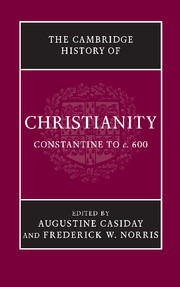Book contents
- Frontmatter
- Introduction
- Part I Christianity: Regional Developments
- Part II Christianity Contested
- Part III Christian Culture and Society
- Part IV Christian Beliefs and Practices
- 18 Discourse on the Trinity
- 19 History of Christology to the seventh century
- 20 Sin and salvation: Experiences and reflections
- 21 From Antioch to Arles: Lay devotion in context
- 22 Saints and holy men
- 23 Pastoral care and discipline
- 24 Sexuality, marriage and the family
- 25 The growth of liturgy and the church year
- 26 Interpreting scripture
- 27 Asceticism and monasticism, I: Eastern
- 28 Asceticism and monasticism, II: Western
- 29 Art and Propaganda fide: Christian art and architecture, 300–600
- Index
- Map 1 The Roman empire, c. 400">
- References
20 - Sin and salvation: Experiences and reflections
from Part IV - Christian Beliefs and Practices
Published online by Cambridge University Press: 28 March 2008
- Frontmatter
- Introduction
- Part I Christianity: Regional Developments
- Part II Christianity Contested
- Part III Christian Culture and Society
- Part IV Christian Beliefs and Practices
- 18 Discourse on the Trinity
- 19 History of Christology to the seventh century
- 20 Sin and salvation: Experiences and reflections
- 21 From Antioch to Arles: Lay devotion in context
- 22 Saints and holy men
- 23 Pastoral care and discipline
- 24 Sexuality, marriage and the family
- 25 The growth of liturgy and the church year
- 26 Interpreting scripture
- 27 Asceticism and monasticism, I: Eastern
- 28 Asceticism and monasticism, II: Western
- 29 Art and Propaganda fide: Christian art and architecture, 300–600
- Index
- Map 1 The Roman empire, c. 400">
- References
Summary
‘The Son of Man is come to seek and save that which is lost’ (Luke 19.19): with this description of their Lord’s mission, Christians understandably came to regard salvation and sin as master themes for their lives. In fact, these themes are so pervasive that discussions of them take on as many forms as Christianity itself does. This near ubiquity makes it exceedingly difficult to appreciate the subject in a way that does justice to evidence from across the Mediterranean basin and Near East; in attempting to navigate through the wealth of information, it is very easy to adopt the categories of regional controversies and subsequently to ascribe universal significance to localised preoccupations. One way forward is to think about how Christians considered baptism (itself a practice that was comparably widespread), which was regarded as a vital step in the process of salvation and indeed as the font of Christian identity. In explaining, preparing for and celebrating this sacrament, Christians of all types were confronted in a powerful way with the dynamics of sin and salvation – and these experiences in turn shaped their habits of reflecting upon salvation. Baptism and the events surrounding it provide important evidence for how Christians during our period understood sin and the measures they took to deal with it, as well as how they conceived of salvation.
Records about early Christian views on baptism survive in a variety of forms, such as catechetical lectures, rites (and commentaries on them), pilgrims’ journals, hymns and letters. As for the former, the justly famous homilies of Cyril of Jerusalem and Theodore of Mopsuestia are but two series of such lectures. Similar instruction survives from Augustine of Hippo, Gregory of Nazianzus, John Chrysostom (from his younger days in Antioch), Quodvultdeus of Carthage, Severus of Antioch and Zeno of Verona.
- Type
- Chapter
- Information
- The Cambridge History of Christianity , pp. 501 - 530Publisher: Cambridge University PressPrint publication year: 2007
References
- 1
- Cited by

